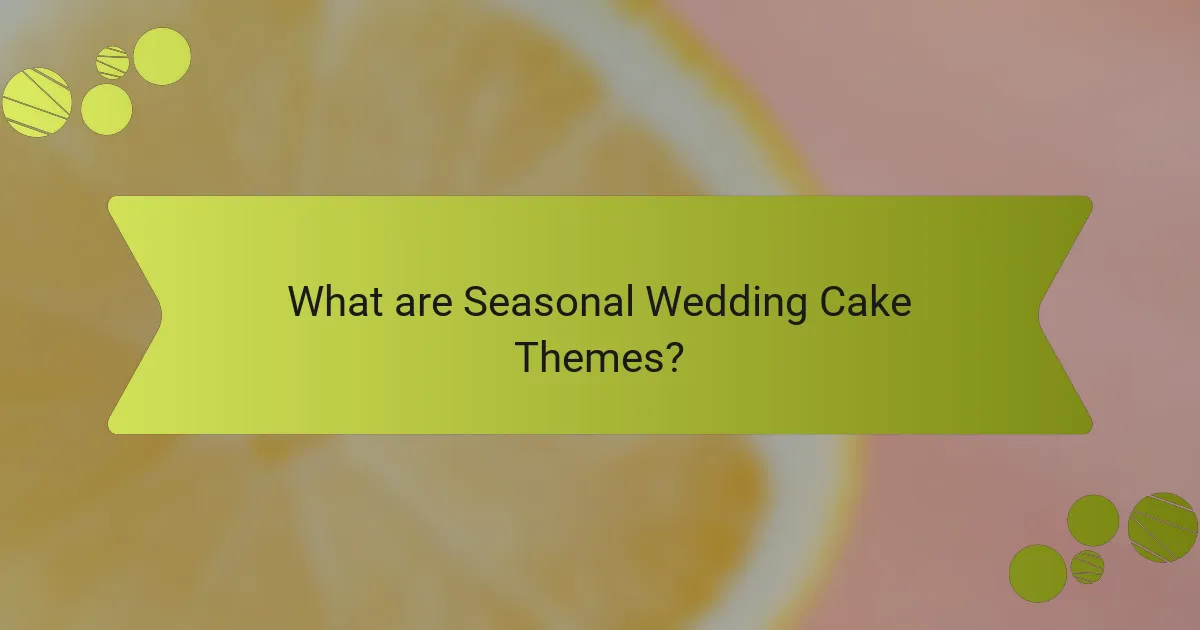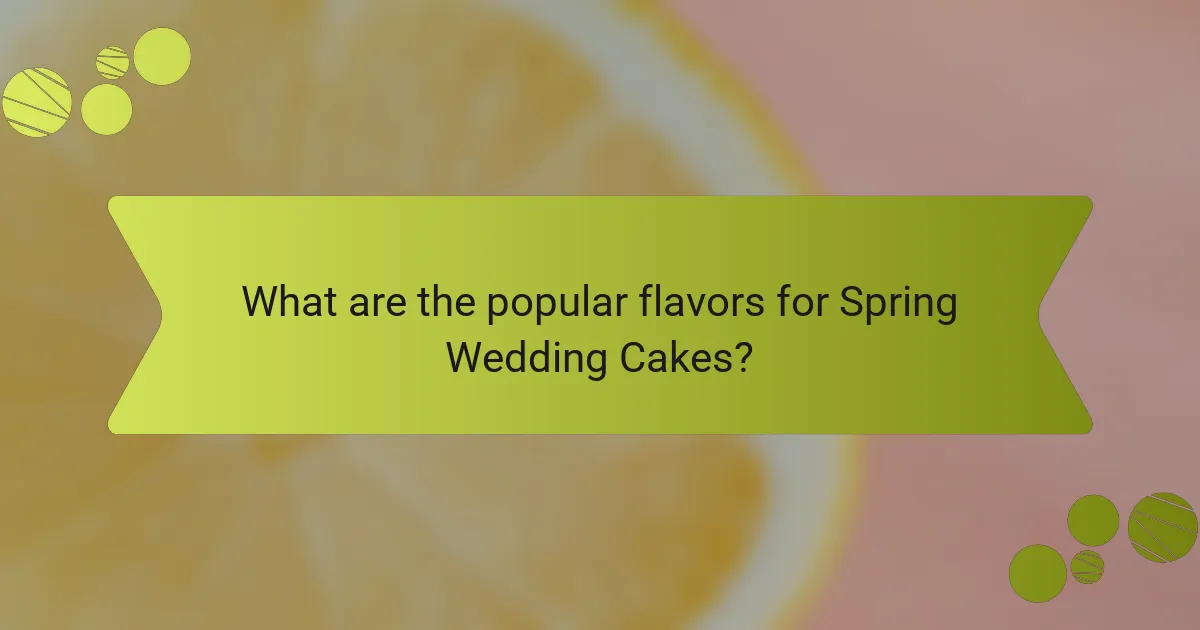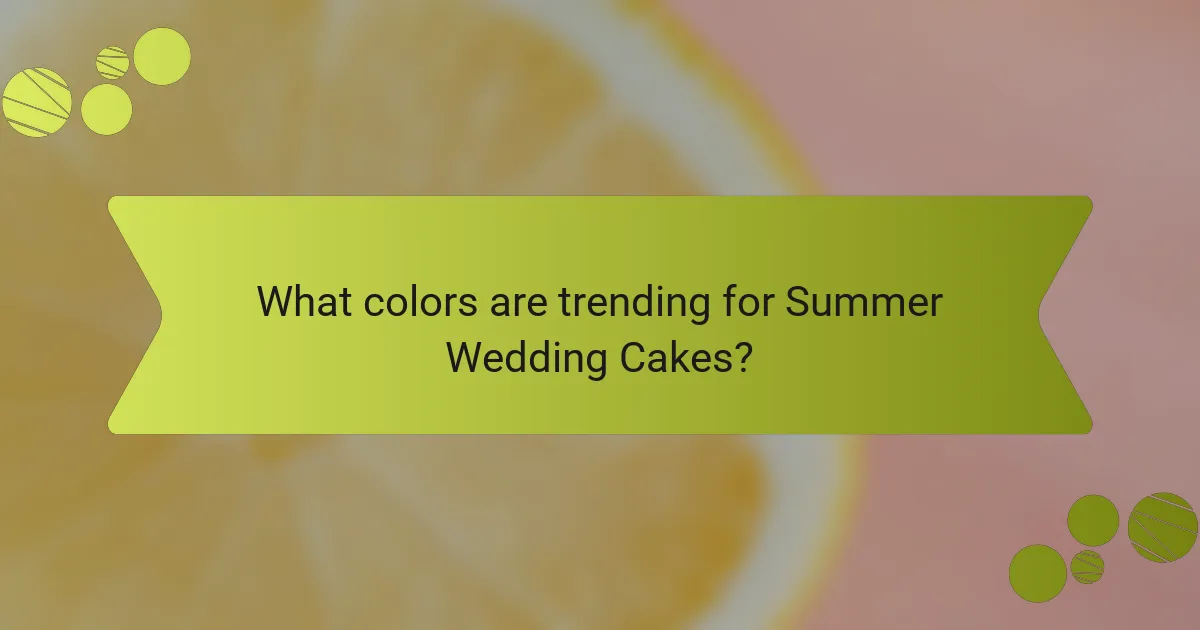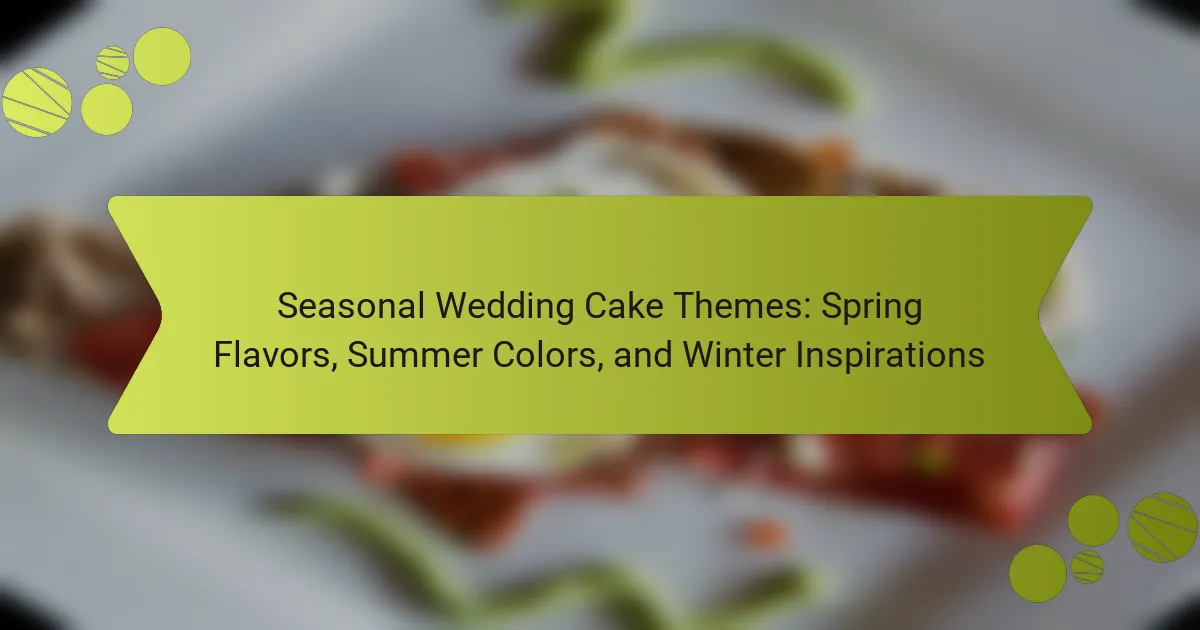Seasonal wedding cake themes are cake designs that reflect the characteristics of specific seasons, incorporating seasonal flavors, colors, and decorations. Spring wedding cakes typically feature floral designs and flavors like lemon and strawberry, while summer cakes showcase bright colors and tropical flavors such as coconut. Autumn cakes often include spice flavors like pumpkin, decorated with fall foliage, and winter cakes are characterized by rich flavors like chocolate, adorned with snowflake designs. This article explores popular flavors and color trends for wedding cakes across different seasons, emphasizing how these themes enhance the overall wedding experience by aligning the cake with the season of the event.

What are Seasonal Wedding Cake Themes?
Seasonal wedding cake themes refer to cake designs that reflect the characteristics of specific seasons. These themes often incorporate seasonal flavors, colors, and decorations. For example, spring cakes may feature floral designs and fruity flavors like lemon or strawberry. Summer cakes often showcase bright colors and tropical flavors such as coconut or pineapple. Autumn cakes might include spice flavors like pumpkin or apple, decorated with fall foliage. Winter cakes typically have rich flavors like chocolate or peppermint, often adorned with snowflake designs or winter greenery. These themes enhance the overall wedding experience by aligning the cake with the season of the event.
How do seasonal themes influence wedding cake design?
Seasonal themes significantly influence wedding cake design by dictating flavors, colors, and decorations. In spring, cakes often feature floral designs and light flavors like lemon or lavender. Summer wedding cakes typically showcase vibrant colors and fruity flavors, such as strawberry or mango. Autumn cakes may incorporate warm hues and spices like pumpkin or cinnamon. Winter cakes often use rich colors and flavors like chocolate or peppermint. These seasonal elements help create a cohesive theme that resonates with the wedding’s overall aesthetic and atmosphere.
What are the key characteristics of spring wedding cakes?
Spring wedding cakes are characterized by light flavors, floral designs, and vibrant colors. Common flavors include lemon, lavender, and strawberry, which reflect the season’s freshness. Floral decorations often feature edible flowers like roses and peonies, enhancing the cake’s aesthetic appeal. Pastel colors such as soft pinks, greens, and yellows are popular choices. Many spring cakes incorporate fresh fruits, adding a natural touch. Textures may vary from smooth buttercream to delicate fondant. Seasonal themes are often reflected in the cake’s overall design. These elements combine to create a cake that embodies the essence of spring celebrations.
How do summer wedding cakes differ in style and flavor?
Summer wedding cakes typically feature lighter styles and refreshing flavors. The designs often incorporate vibrant colors and floral decorations. Common flavors include citrus, berries, and tropical fruits. These flavors complement the warm weather and outdoor settings of summer weddings. Additionally, summer cakes may utilize lighter frostings, such as whipped cream or fruit-based glazes. This contrasts with richer flavors often found in winter cakes. The use of fresh, seasonal ingredients enhances the overall taste and aesthetic.
What inspirations can be drawn from winter for wedding cakes?
Winter inspirations for wedding cakes include snowy white designs, rustic elements, and seasonal flavors. Snowy white designs often feature fondant or buttercream that mimic the look of fresh snow. Rustic elements can incorporate wood textures, pinecones, and evergreen foliage for a cozy feel. Seasonal flavors might include spiced cakes, such as gingerbread or cinnamon, reflecting winter spices. Additionally, cakes can be adorned with icicles or crystal-like sugar decorations to evoke a frosty atmosphere. These themes resonate with the winter season, creating a magical and romantic ambiance for weddings.
Why choose a seasonal wedding cake theme?
Choosing a seasonal wedding cake theme enhances the overall wedding experience. Seasonal themes align with the time of year, creating a cohesive aesthetic. For example, spring cakes often feature fresh flowers and fruit flavors. Summer cakes can incorporate bright colors and tropical ingredients. Autumn cakes may highlight spiced flavors and warm hues. Winter cakes often showcase rich flavors and elegant designs. This alignment with the season can evoke specific emotions and memories. Additionally, seasonal ingredients are often fresher and more flavorful. This can improve the taste and quality of the cake. Overall, a seasonal wedding cake theme adds a unique touch to the celebration.
What benefits do seasonal flavors bring to wedding cakes?
Seasonal flavors enhance wedding cakes by providing freshness and relevance. They align the cake’s taste with the time of year, creating a cohesive theme. Seasonal ingredients often boast superior flavor and quality. For example, summer cakes can feature fruits like strawberries and peaches, which are at their peak. This freshness translates to a more vibrant taste experience for guests. Additionally, incorporating seasonal flavors can evoke emotions tied to specific times of the year. This connection can make the wedding more memorable for couples and guests alike. Ultimately, seasonal flavors contribute to a unique and personalized wedding cake experience.
How can seasonal colors enhance the overall wedding aesthetic?
Seasonal colors enhance the overall wedding aesthetic by creating a cohesive and visually appealing theme. They evoke specific emotions associated with each season. For example, spring colors like pastels symbolize renewal and freshness. Summer colors such as vibrant hues convey joy and warmth. Autumn colors reflect richness and comfort, while winter colors can bring elegance and serenity. Using these palettes can unify decorations, floral arrangements, and attire. Studies show that color psychology impacts mood, reinforcing the desired atmosphere for the event. Seasonal colors can also highlight the natural beauty of the surroundings, making the wedding more memorable.

What are the popular flavors for Spring Wedding Cakes?
Popular flavors for Spring Wedding Cakes include lemon, vanilla bean, and strawberry. Lemon offers a refreshing citrus taste, ideal for spring. Vanilla bean provides a classic flavor that pairs well with seasonal fruits. Strawberry adds a sweet, fruity element that resonates with spring themes. Additionally, flavors like almond and lavender are also favored during this season. These flavors align with the light and fresh aesthetic of spring weddings.
Which fruits are ideal for spring wedding cake flavors?
Strawberries, raspberries, lemons, and cherries are ideal fruits for spring wedding cake flavors. Strawberries offer a sweet and tart flavor that complements many cake types. Raspberries add a vibrant color and a tangy taste. Lemons provide a refreshing citrus note, perfect for light spring cakes. Cherries bring a rich sweetness and a pop of color. These fruits are typically in season during spring, ensuring freshness and flavor. Their bright colors and flavors enhance the celebratory nature of spring weddings.
How do floral flavors contribute to spring wedding cakes?
Floral flavors enhance spring wedding cakes by adding freshness and elegance. These flavors, such as lavender, rose, and hibiscus, evoke the essence of spring blooms. Incorporating floral elements creates a light and airy taste profile. This aligns with the seasonal theme of renewal and celebration. Floral flavors also pair well with traditional cake bases, enhancing overall flavor complexity. Additionally, they can be visually appealing, complementing the cake’s aesthetic. Many couples choose floral flavors for their symbolic meanings, such as love and beauty. This trend reflects a growing preference for natural and organic ingredients in wedding desserts.
What unique flavor combinations are trending for spring cakes?
Lavender and lemon is a trending flavor combination for spring cakes. This pairing offers a fresh, floral taste balanced by citrusy brightness. Another popular combination is strawberry and basil, which provides a sweet and savory contrast. Additionally, honey and chamomile is gaining attention for its soothing and aromatic qualities. These unique flavors reflect the seasonal shift towards lighter, more vibrant desserts. The use of herbs and floral notes in cakes enhances their appeal for spring celebrations.
How do seasonal ingredients affect cake flavor?
Seasonal ingredients significantly enhance cake flavor by introducing fresh and vibrant tastes. Ingredients such as strawberries in spring or pumpkin in fall provide unique profiles. Seasonal fruits and spices often have peak ripeness and flavor during their respective seasons. For instance, ripe strawberries are sweeter and more aromatic in spring. This freshness translates into cakes, making them more flavorful. Seasonal ingredients also reflect the essence of the time of year, creating a connection to the season. Using local, seasonal produce can elevate the overall quality of the cake. Studies show that freshness impacts flavor intensity, confirming the importance of seasonal sourcing.
What are the benefits of using fresh, seasonal ingredients?
Fresh, seasonal ingredients enhance flavor and nutritional value in dishes. They are harvested at peak ripeness, ensuring optimal taste. Seasonal ingredients are often more affordable due to local abundance. They support local farmers and reduce carbon footprint from transportation. Using these ingredients promotes sustainability and food diversity. Studies show that fresh produce can have higher vitamin content. For example, tomatoes picked at peak season have significantly more lycopene compared to out-of-season varieties. Fresh, seasonal ingredients also inspire creativity in culinary presentations.
How do local ingredients influence flavor profiles?
Local ingredients significantly influence flavor profiles by reflecting the terroir and seasonality of a region. Freshness enhances the taste and aroma of baked goods. For example, local fruits like strawberries or peaches offer vibrant flavors during their peak seasons. Herbs and spices grown nearby add unique and authentic notes to recipes. The use of local dairy products can also enrich the creaminess and texture of frostings. Additionally, regional culinary traditions shape the flavor combinations that are favored in specific areas. Research indicates that ingredients sourced close to home often have higher nutritional value and taste due to reduced transportation time. This connection to local agriculture fosters a deeper appreciation for the flavors in seasonal wedding cakes.

What colors are trending for Summer Wedding Cakes?
Pastel colors are trending for summer wedding cakes. Soft shades like blush pink, lavender, and mint green are popular choices. Bright colors such as coral, sunny yellow, and turquoise are also in vogue. These colors evoke a fresh and vibrant summer feel. According to wedding industry reports, pastel palettes create a romantic atmosphere. Bright hues add a fun and festive touch to celebrations. Wedding cake designers are increasingly incorporating these colors into their creations. The trend reflects a desire for personalization and unique aesthetics in summer weddings.
How do summer colors reflect the season’s vibrancy?
Summer colors reflect the season’s vibrancy through their brightness and warmth. These colors typically include vivid shades like yellow, orange, pink, and turquoise. Bright colors evoke feelings of joy and energy, aligning with the lively atmosphere of summer. Studies show that warm colors can increase feelings of happiness and excitement. For example, yellow is often associated with sunshine and positivity. Similarly, vibrant pinks can symbolize playfulness and romance, making them popular in summer themes. The combination of these colors creates a lively palette that enhances celebrations, such as weddings. This use of color not only beautifies but also embodies the essence of summer’s joyful spirit.
What color palettes are popular for summer wedding cakes?
Popular color palettes for summer wedding cakes include pastel shades, vibrant hues, and tropical colors. Pastel palettes often feature soft pinks, light blues, and mint greens. Vibrant hues typically consist of bold yellows, oranges, and fuchsias. Tropical colors may incorporate bright greens, corals, and turquoise. These palettes reflect the lively and warm essence of summer weddings. According to wedding industry trends, such colors enhance the festive atmosphere and complement seasonal floral arrangements.
How can contrasting colors enhance cake design?
Contrasting colors can significantly enhance cake design by creating visual interest and depth. They draw attention to specific elements of the cake. For example, a vibrant blue frosting can make white decorations pop. This contrast helps highlight intricate details, such as piping or fondant work. Additionally, contrasting colors can evoke emotions and set a theme. A combination of bold red and soft pink can convey romance, suitable for weddings. Research shows that color contrast impacts perception and can make designs appear more appealing. Cakes designed with contrasting colors often stand out in photographs, making them memorable for events.
What are the best decoration techniques for summer cakes?
The best decoration techniques for summer cakes include fresh fruit, edible flowers, and light frosting. Fresh fruit adds vibrant colors and natural sweetness. Common choices are berries, peaches, and citrus slices. Edible flowers enhance visual appeal and bring a garden-fresh feel. Popular options include pansies, nasturtiums, and lavender. Light frosting techniques, such as whipped cream or cream cheese, create a refreshing taste. Additionally, using a [censured] cake style showcases layers and fillings, appealing in summer. These techniques align with seasonal aesthetics and flavors, making cakes visually stunning and enjoyable.
How can edible flowers be used creatively in summer cakes?
Edible flowers can enhance summer cakes through decoration and flavor infusion. They add vibrant colors and visual appeal. Common edible flowers include lavender, nasturtiums, and pansies. These flowers can be used to create beautiful cake toppers. They can also be incorporated into the batter for unique flavors. For instance, lavender adds a subtle floral note. Additionally, flowers can be crystallized for a sweet garnish. This technique preserves their beauty and adds a sugary crunch. Using edible flowers elevates the overall aesthetic and taste of summer cakes.
What role do vibrant icing and fondant play in summer designs?
Vibrant icing and fondant enhance summer designs by adding color and visual appeal. These elements bring a lively aesthetic that reflects the season’s brightness. Summer cakes often feature bold hues like bright yellows, pinks, and blues. These colors evoke feelings of warmth and joy, aligning with summer celebrations. Fondant allows for smooth finishes and intricate designs, making it ideal for summer themes. Icing can be used to create textures that mimic summer elements, such as waves or flowers. The use of vibrant colors also makes cakes stand out at outdoor events. Therefore, vibrant icing and fondant are essential for creating attractive summer-themed wedding cakes.
